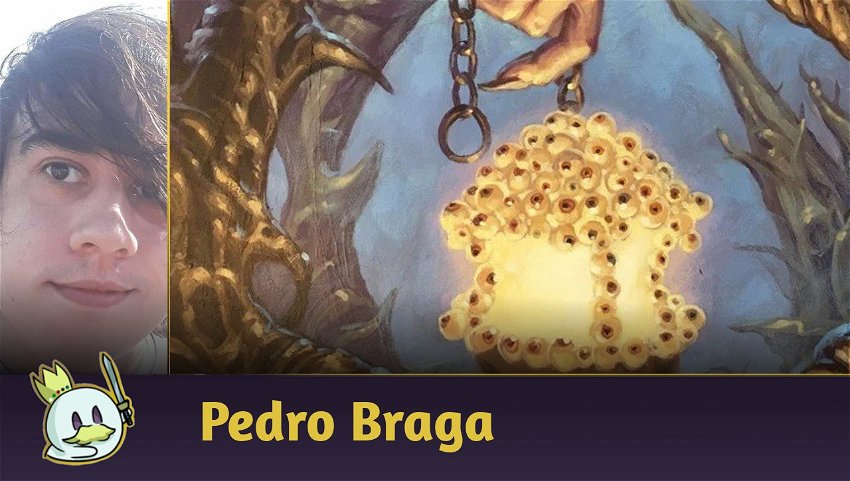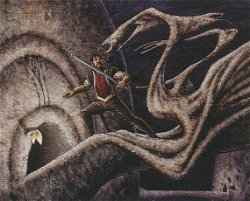Magic: The Gathering has always been known for its diverse decks and strategies, and Lantern Control, in past times, stood out as an extremely unusual archetype, capable of inciting rage and indignation in players. With an unusual control approach, based on manipulating your opponent's deck, Lantern control brought new tactical challenges and provided extremely technical and unnerving matches.
Nowadays, the deck is an ancient jewel in this format, but it is frequently remembered as a horrible deck to go against, and extremely hard to pilot too. Its nuances, technicalities, and mostly its weaknesses and the reasons the deck lost its strength, will all be explored in this article.
The Deck
The deck is formed by a strong core of artifacts, which we'll use to manage and control the game's flow. Lantern is a very slow and complicated deck. Its aim was spending the best of three's full time to win just the first game, this way leaving your opponent at a disadvantage, as it dug for victories and ties which would benefit it in tournament standings.
Precisely for that reason, players who went to big events with eight or nine rounds with Lantern were thought to be heroes, because playing with this deck meant they would spend the round's full time just thinking about the several diverse plays available and delaying the game more and more.
The deck came out "of nowhere", winning Oklahoma City's Grand Prix in 2015 at the hands of Zac Elsik, its creator. The list even placed above decks which were better placed in the meta, such as Splinter Twin, for instance. This tournament victory was claimed with the following list:
This is a more recent version of the deck, used in 2017 by Alexander Beiersdofer at the main event of a big tournament in Frankfurt, Germany:
The Deck's Core

Lantern Control had a very simple game engine, which combined cards such as Ghoulcaller’s Bell, Codex Shredder and Pyxis of Pandemonium, three low-cost artifacts, with the same goal: Milling the opponent's deck one card at a time. Some of them milled cards in our own deck too, but that wasn't an issue. Our goal with these artifacts is precisely milling opponent cards slowly, regardless of efficiency. Describing it this way, it seems a sadistic deck, but we can make it even worse.
Thanks to Lantern of Insight, the card which grants this deck's name its "Lantern" part, we can always see our opponent's top card. This way, our goal becomes clear. As much as gathering four Codex Shredder and four Ghoulcaller’s Bell on board is cool, as this way you'll guarantee eight cards are milled every round, this deck's isn't trying to be a slow Mill strategy which will gradually gather resources to mill your opponent more and more, but instead, it is something even more Machiavellian. It is a deck with which you'll control your opponent's draws, one by one. This is another factor which made Lantern hard to pilot: you had to know, by heart, in and out, all other decks you might face.
As this deck is trying to precisely control your opponent's draws, it was necessary to understand the combos, the needs and the priorities of each deck it faced. The Lantern player should always know what they were doing, and this way give more lands to a Burn player, fewer lands to the Amulet Titan player, and always give the same copy of Urza's Land to the Tron player, which prevented them from completing their trio, for instance.
We can also use the land Inventor’s Fair to look for any pieces we need at that moment, which boosted the deck's consistency and helped us replace a piece we have sacrificed to use one of its other effects, such as the one which forces our opponent to shuffle their own deck, for instance.
Thanks to that, it wasn't hard to see Lantern Control matches taking up the whole round and the player finishing the set 1-0, managing to get a win through the clock.
The Rest of the Control

Even then, there will be situations in which we'll need to control the game in the traditional sense, and for that, we used the good old Abrupt Decay, which today would be replaced by Assassin’s Trophy, and other cards which forced our opponents to discard a card, such as Thoughtseize, Inquisition of Kozilek and Collective Brutality, this way starting the match disabling the opponent's game evolution or removing any key piece the other player had managed to get their hands on.
Besides that, being able to check our opponent's hand is of utmost importance to Lantern Control, as this will give us a good idea of the opponent's current game state, which will help you decide what to mill and what to place as their top card in the deck.

Ensnaring Bridge is another very solid control piece we can find in this deck. As one of the main pieces to delay Modern games, and any Magic game, for that matter, we have in this bridge an important way of holding off enemy attacks and holding on to your life.
Academy Ruins is another very interesting engine for control strategies. With it, we can create loops with graveyard artifacts. The most obvious would be Lantern of Insight and others, such as Welding Jar from the sideboard, but we also have other options, such as Pyrite Spellbomb, which is capable of sequencing damage throughout turns and leading the opponent through a slow health point loss until their inevitable defeat.
Sideboard
We'll discuss the sideboard in both lists presented at the beginning of the article:
We'll begin discussing the sideboard with Welding Jar, a classic way of protecting your artifacts. Obviously, it was used when your opponents presented some option capable of destroying your Lantern of Insight, Codex Shredder and others.
Grafdigger’s Cage prevented situations connected to the graveyard from happening, which really helped against Reanimator and Dredge. Meanwhile, Leyline of Sanctity and Sun Droplet are both cards used in the sideboard against Burn, protecting the player from being targeted and giving them life. Pyroclasm is also useful to deal with small creatures in those decks.
In Zac Elsik's original deck, we have Ghirapur Aether Grid in the mainboard, but with time it was moved to the sideboard. This enchantment's idea is to work as an extra wincon, helping Lantern Control deal small portions of damage when we tap two artifacts.
Extra copies of Pithing Needle, Surgical Extraction and Abrupt Decay can also be found in the sideboard in case the situation calls for them.
A card that can be moved from the mainboard in many situations is Ensnaring Bridge itself, when you're against decks with just a few creatures or even no creatures at all. The same goes for Pithing Needle in the matches in which Needle isn't necessary.
The End of Lantern
As we discussed early on, Lantern Control went through quite a lot through the years, as time brought new things to Magic. War of the Spark brought us Karn the Great Creator and a bit after its release, we had June 2019, the month we were faced with Modern Horizons, the set known for bringing to an eternal format the concept of rotation. In this set, we were faced with two very strong enemies to our deck: Force of Vigor and Collector Ouphe.
Collector Ouphe works just like Karn the Great Creator, which was released just a short while before, and locked down activated abilities of all artifacts in play, not allowing us to activate them. Ouphe is a great sideboard against Lantern, and as for Karn, it is much more prominent in mainboards.
Force of Vigor is the real problem here. Much more than disabling artifact's activated abilities, this instant spell can destroy two at once, greatly disrupting this strategy, and even with Academy Ruins, it will bring a huge disadvantage to this deck.
Besides that, Mox Opal was banned just a few months later, which really made it hard for this deck to produce colorful mana in different colors, which greatly slowed down its game style.
As if Force of Vigor destroying multiple artifacts consecutively at a low cost wasn't enough, we had the release of Boseiju, Who Endures, a card capable of easily breaking artifacts, and it can't be discarded with Thoughtseize and the like.
The difficulty and exhaustion related to repeatedly playing Lantern and the later indirect blows to the deck with the release of more and more cards, made this deck, once promising, fall from grace, and be forgotten. Nowadays, no one mentions Lantern Control without treating it as a treasure from the past.
Final Words

As frustrating as it was to face Lantern Control, we could argue it was, yes, a healthy deck, once you needed to know the game at an expert level and know its nuances by heart to play it. Despite being a miserable experience for some players to have to face this deck, it wasn't popular or relevant enough in the metagame to become a plague.
Still, the deck was feared in Magic: The Gathering Online leagues, and FNMs across the world, enough to make any opponent which knew what they were about to face for the next 50 minutes shiver.
Lantern's loss really is a pity, as we lost a deck that many loved, and many loved hating. Who knows, maybe it can come back with some new techs, or even get a Pioneer version with some of its reprints?
See you next time!















— 评论 0
, 反应 1
成为第一个发表评论的人